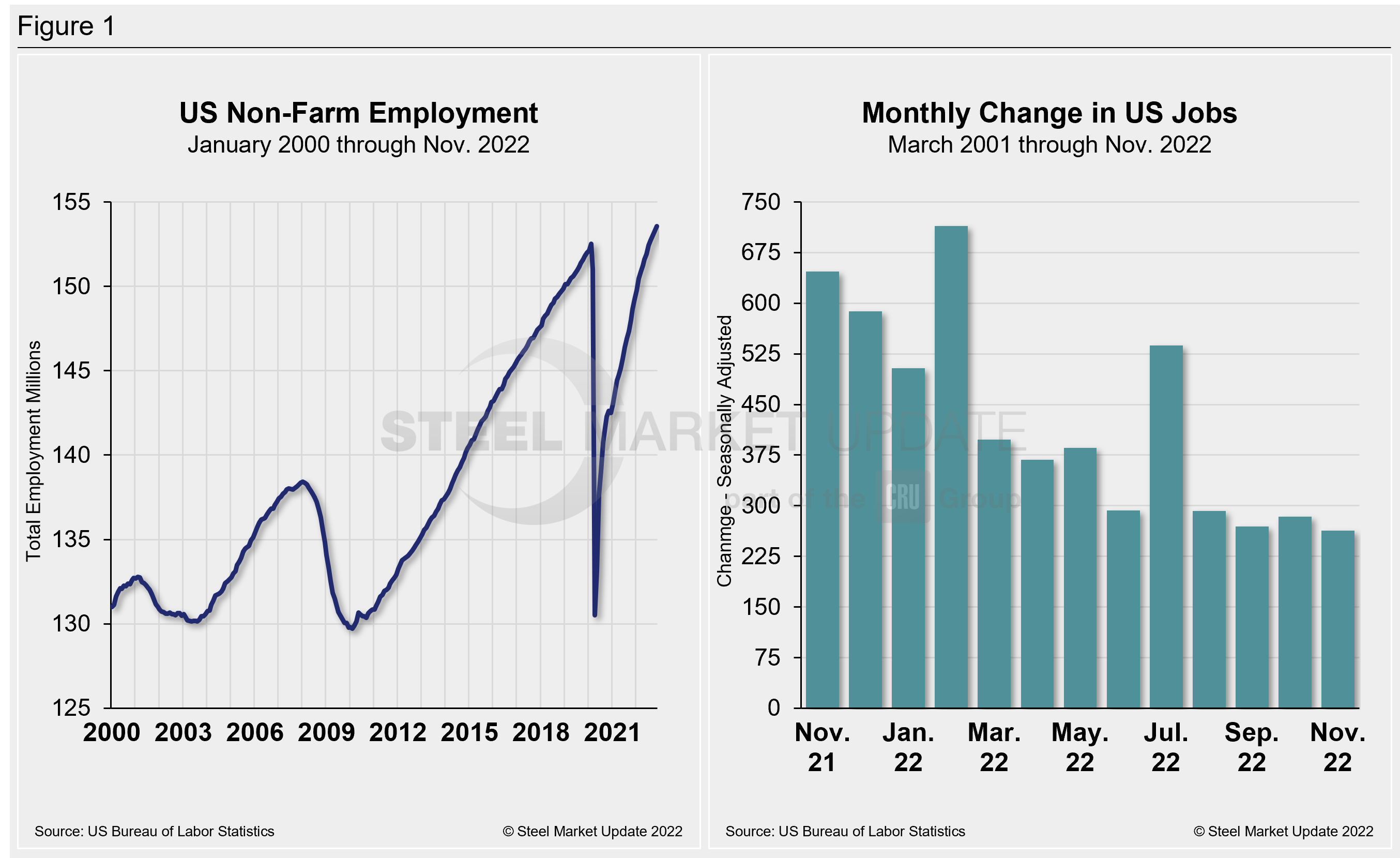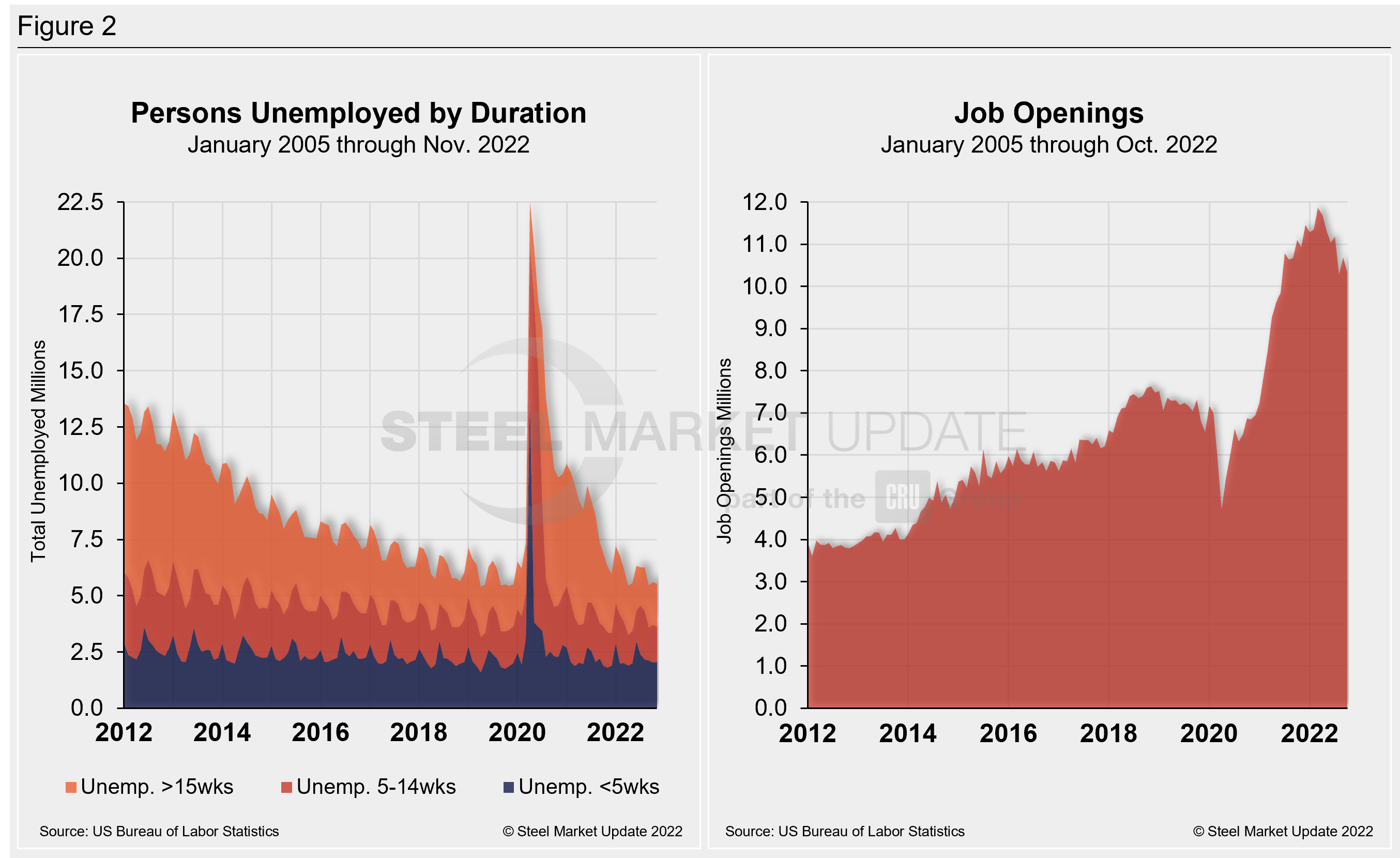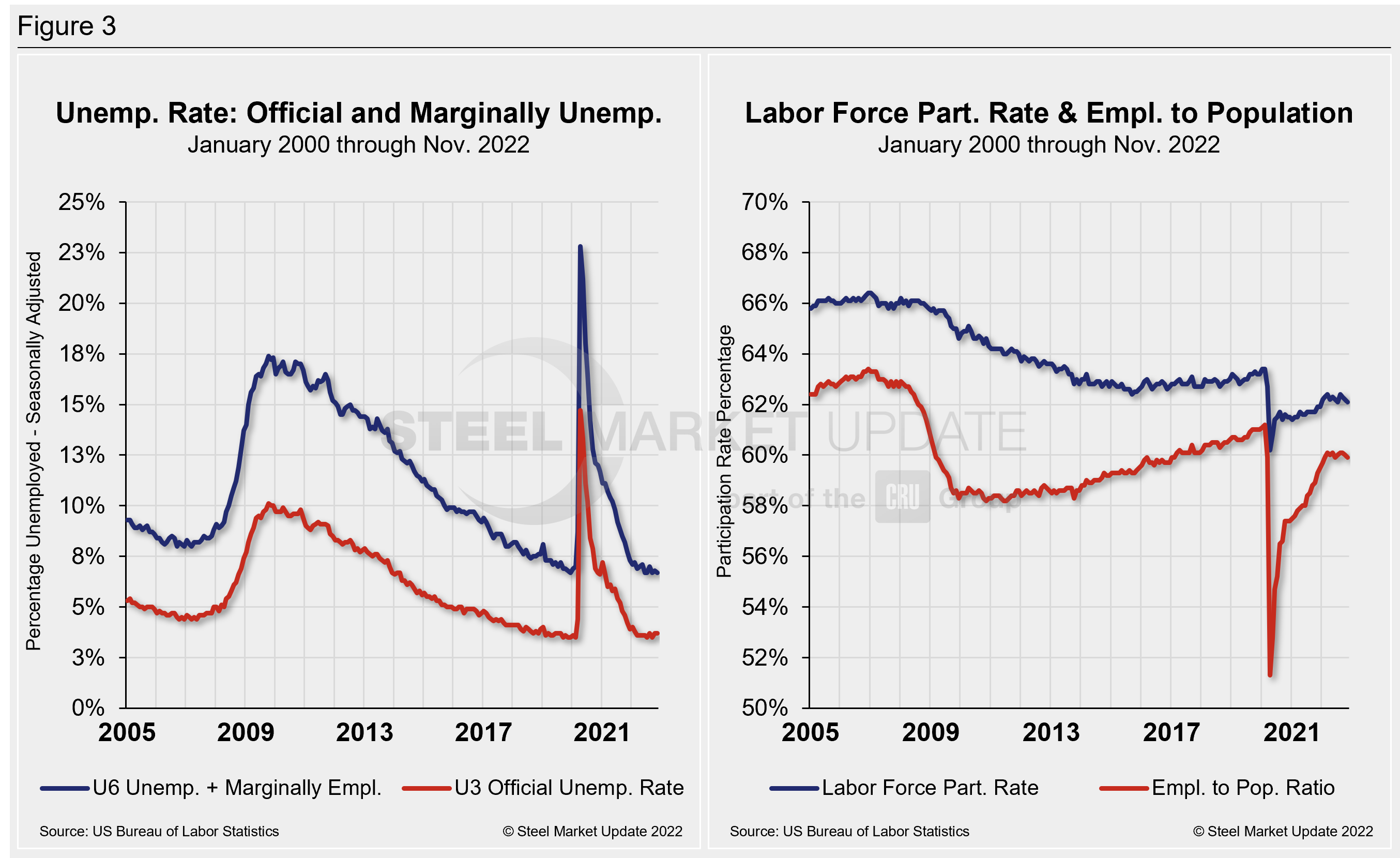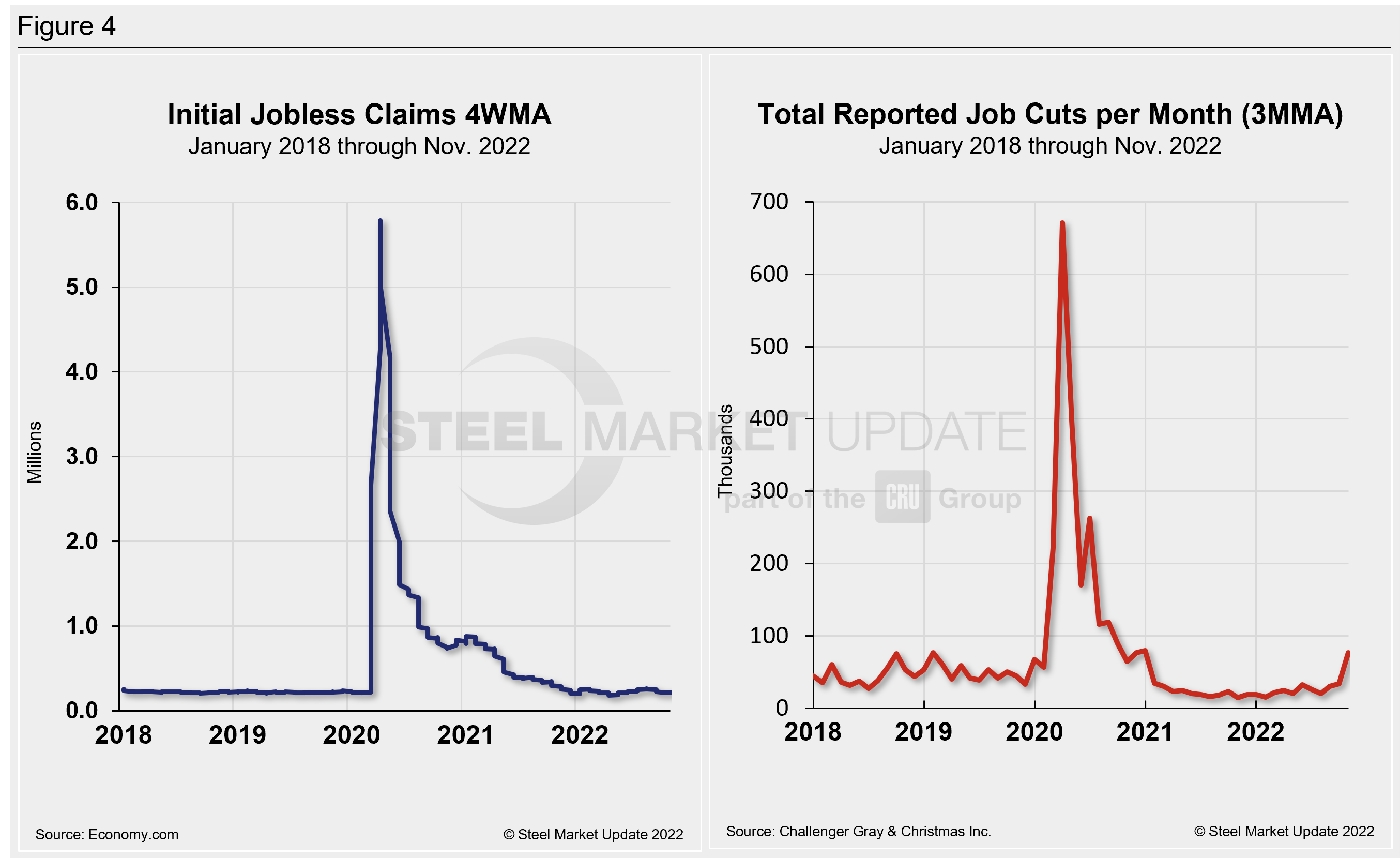Steel Mills

US Job Creation Outpaces Expectations in November
Written by David Schollaert
December 7, 2022
The US economy added 263,000 new jobs in November, again outperforming consensus expectations but slightly decreasing from October’s upwardly revised 284,000, according to data from the US Department of Labor.
November’s job growth was much better than expected despite the Federal Reserve’s aggressive efforts to slow the labor market and tackle inflation. The jobless rate was unchanged last month at 3.7%.
Despite the slowdown in hiring, last month’s total was still somewhat resilient and solid by pre-pandemic standards.
Employment growth was again widespread across industries last month, with leisure and hospitality leading the job gains, while health care, government, and other services also showed big gains.
Side-by-side in Figure 1 below is a snapshot of the pace of hiring since April 2021 and the total number of non-farm workers employed in the US since 2000.

The number of long-term unemployed (out of work for at least 27 consecutive weeks) was little changed in November, totaling 1.2 million. That figure accounted for 20.6% of the total unemployed in the month.
The historic picture for the duration of unemployment since January 2005 is broken down into <5 weeks, 5–14 weeks, and >15 weeks in Figure 2. The total number of unemployed was largely unchanged at 6 million at the end of November. The increase put the result 695,000 below the pre-pandemic unemployment total in February 2020.
November’s results show that nearly 17 million more people now have jobs compared to the 22.5 million thrown out of work during the worst of the pandemic in April 2020. As of Dec. 7, 35% had been unemployed for more than 15 weeks, 28% for 5 to 14 weeks, and 37% for less than five weeks.
As part of November’s employment report, the Labor Department released its monthly report on job openings, layoffs, and quitting through the last day of October. Also known as the “JOLTS” report, the data indicates how much demand there is for workers in the US economy and the extent to which employers are still struggling with labor shortages nearly two years removed from the worst of the pandemic.
October’s job openings declined month-on-month (MoM) after edging higher the month before. The report suggests that workers remain in high demand and are still quitting more often. There were about 10.3 million job openings in October — 353,000 fewer openings than in September and 1.5 million fewer than the record of 11.9 million set in March.
The charts below (Figure 2) detail the total persons unemployed by duration from 2005 through October 2022 and the total job openings over the same period.

The official unemployment rate, U3, reported in the Bureau of Labor Statistics Household survey (see explanation below), increased from 3.5% in February 2020 to 14.7% in April 2020. A steady decrease followed until a slight increase in March. November’s measure of 3.7% is unchanged MoM and is no longer in pre-pandemic form as it had been.
A more encompassing view of unemployment (U6) that includes those holding part-time jobs for economic reasons, as well as discouraged workers not looking for jobs, was 6.7% in November, down from 6.8% in October.
Another gauge, and a more definitive view, are the number employed as a percentage of the population. Last month, the employment-to-population ratio was 59.9%, down 0.1 percentage point versus October, and down for the third straight month.
Figure 3 details side-by-side parallels of the unemployment rate (both the U3 and U6 rates) since 2005 as well as the labor force participation rate and employment-to-population ratio over the same period.

Initial claims for unemployment insurance, which are reported weekly by the Department of Labor, declined in the week ended Dec. 3, totaling 225,000 but up by 8,000 new claims since our last report a month ago. Despite the MoM increase, they remain historically low and well below the 250,000 threshold and reflective of a strong labor market, the Department of Labor said.
The four-week moving average of initial claims ticked higher, reaching the highest total since mid-July, Economy.com reported.
Human resources consulting firm Challenger, Gray and Christmas Inc. produces a monthly employment update for the US. It reported that job cuts in November totaled 76,835 — a surge of 127% from the 33,843 announced the previous month. November’s total is 417% higher than the same year-ago period when just 14,875 cuts were announced.
November marks the sixth time this year that cuts were higher in 2022 than in the corresponding month a year earlier, the report said.
Year-to-date (YTD), employers announced 320,173 cuts, up 6% from the 302,918 cuts announced through the same period in 2021. With November’s total, job cuts in 2022 have surpassed cuts announced in 2021 for the first time this year.
Cuts were widespread in October. Technology companies led in job cut announcements last month, with 52,771, bringing total cuts YTD to 80,978, a 535% YoY surge in the sector. Other cuts included automotive, construction, and real estate, the report said.
Figure 4 shows the four-week moving average of new claims since January 2018, seasonally adjusted. It also shows the total reported job cuts per month, according to Challenger, on a three-month moving average.

Explanation: On the first Friday of each month, the Bureau of Labor Statistics releases the employment data for the previous month. Data is available at www.bls.gov. The BLS reports on the results of two surveys. The Establishment survey reports the actual number employed by industry. The Household survey reports on the unemployment rate, participation rate, earnings, average workweek, the breakout into full-time and part-time workers and lots more details describing the age breakdown of the unemployed, reasons for and duration of unemployment.
By David Schollaert, David@SteelMarketUpdate.com

David Schollaert
Read more from David SchollaertLatest in Steel Mills

Algoma fires up EAF steelmaking with first arc
Algoma Steel reached a milestone in its transformation from blast furnace to electric arc furnace (EAF) steelmaking, with its Unit One EAF achieving its first steel production this week.

Nucor holds HR list price at $910/ton
Nucor is keeping its list price for spot hot-rolled coil unchanged after last week’s shortened holiday week.

Cliffs unveils new hydrogen-powered stainless line in Ohio
CEO Lourenco Goncalves, flanked by state leaders and union reps, touted the project as proof that US manufacturing is not only alive, but also advancing.

Cliffs idles Steelton, Riverdale, and Conshohocken operations
Cliffs has idled facilities in Riverdale, Ill., and Conshohocken and Steelton, Pa.

Radius loss narrows, volumes climb in ‘healthy’ West Coast market
Stronger steel demand in the Western US, rising scrap flows, and improved rolling mill utilization drove sequential gains for Portland, Ore.-based Radius Recycling.
